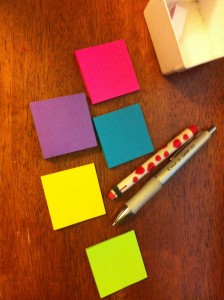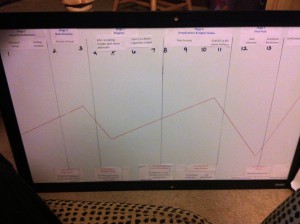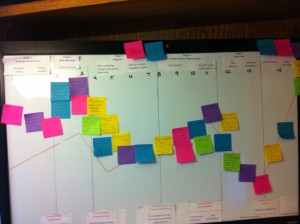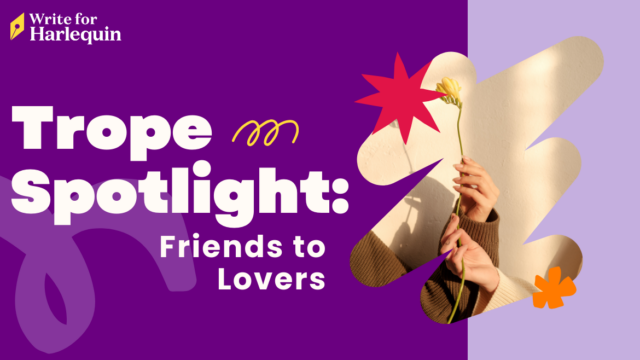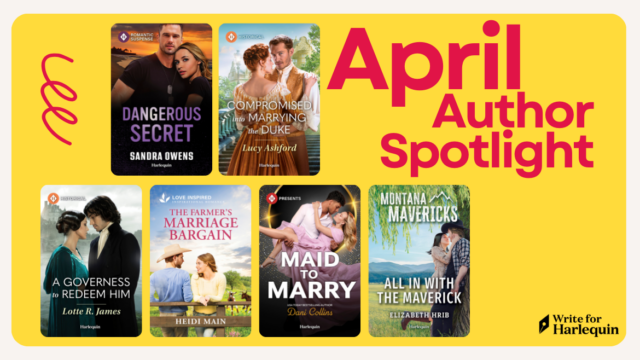Writing a novel is a big undertaking. Where do you even start? We asked two Harlequin authors to share their plotting process with you!
My Color Coded Plotting Process
by Tawny Weber, Harlequin Blaze and HQN author
I’ll admit it… I’m hooked on my plotting process. First of all, after 35 books, I know it works. Second, after a decade of fine-tuning, it’s become second nature. And best of all, it gives me the good feelings. You know the ones… they kind of tingle.
But as proudly as I like to wave the Plotter banner, I’m not a detailed plotter. I don’t plot in order. I never know my turning points, I’m iffy on theme and I usually only have a vague idea of the story details. My plotting is basically broad strokes with a lot of wiggle room.
I need three things to start a story; A premise, a decent handle on the characters and a solid idea of the dark moment, or more specifically where the story is going. I don’t always get them in the same order, sometimes characters come first, sometimes it’s the dark moment or the premise. Without them, I tend to write in circles.
But it doesn’t matter how solidly I think I have them nailed down, it still gets interesting once I actually start writing. Oh, they always get me through the first three chapters, but by the time that partial is finished, it’s never quite what I’d thought it would be. The premise shifts, the characters come together differently than I’d envisioned or their motivation simply doesn’t work with the projected dark moment.
That’s when I rewrite the partial. And sometimes I end up rewriting it again. Once in awhile, I even write it yet again! I actually spend longer writing the first three chapters of my story than I do writing the entire rest put together. But once I get those first 3 chapters solid, I finally break out my well-loved plotting board!
OMG, my plotting board! And my colored sticky notes! It could very well be that I started writing just for an excuse to play with colored sticky notes. One of the reasons I love doing plotting boards with colored sticky notes is to check the story elements. I can see if the hero and heroine both have storylines and move toward their emotional resolution. Purple sticky notes help me make sure there is enough sexy stuff to work for Blaze. The yellow plot notes help to ensure that whatever threads I introduce are resolved, and that it keeps the story moving toward that dark moment. And I usually have a minor subplot sticky, something that ties back to the premise. In my SEAL books, that’s usually the military angle.
My plotting boards aren’t very detailed. One sticky note might say ‘love scene,’ and another might say ‘party.’ Yet another might mention the hero’s issues that will probably come to a head at that point in the story, but the sticky note won’t say how. Because I don’t know how. For me, the plotting board is a road map, a general guide from here to there. I think it’s the act of creating the plotting board that makes the rest of the story fly through my keyboard.
Or at least I like to think that because, well, hey –I love playing with sticky notes!! And what can I say? That’s my process. Gotta go with the tingles.
My Writing Process
by Jennifer Faye, Harlequin Romance author
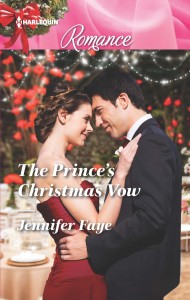 In the beginning, I didn’t do any planning—zero plotting. I wrote everything from the seat of my pants, including writing myself into some corners. It took a while to find my process. I tried all sorts of ways to start books from poster boards and colored stickies to maps. In the end, I found Plotting via Motivation, a course taught by Laurie Schnebly Campbell. It clicked for me, and I use it as a jumping-off point. It gets me to dig deep into my characters and find what drives them. Most of the time, it keeps my editor from saying that I haven’t gone deep enough with my characters or my book is focused too much on the external conflict.
In the beginning, I didn’t do any planning—zero plotting. I wrote everything from the seat of my pants, including writing myself into some corners. It took a while to find my process. I tried all sorts of ways to start books from poster boards and colored stickies to maps. In the end, I found Plotting via Motivation, a course taught by Laurie Schnebly Campbell. It clicked for me, and I use it as a jumping-off point. It gets me to dig deep into my characters and find what drives them. Most of the time, it keeps my editor from saying that I haven’t gone deep enough with my characters or my book is focused too much on the external conflict.
Some people say that plotting takes away the element of surprise when writing a story, but it doesn’t for me. There are still surprises no matter how detailed my synopsis may be. My characters regularly take detours. The key is that one path or the other will lead them back to the synopsis.
Do I have a particular writing process? Yes. And I’ve learned the hard way not to divert from it without dire consequences. LOL. For example, once I tried to skip writing the synopsis. It was a disaster. I wrote myself into a wall. I couldn’t go any further. I literally had to stop writing and work on the synopsis in order to finish the book. I now know to stick with what works for me. 😉
Here’s an overview:
- Grab mug of black tea, a throw blanket and Writer Kitty. 😉
- With pen and paper in hand, I answer the big questions first: Where? When (holiday/spring/summer/fall)? Single or series?
- What are each character’s goals (internal and external)?
- What motivates my characters?
- What are their names (I have to get to know them a bit before their names come to me)?
- Then I hand write a very simple, short synopsis (just a page or two), plugging in the things I learned previously. This step focuses on simply the turning points in the book such as what do they want, what will stand in their way and in the end do they actually get what they originally wanted? Or do they find that they already had what was important? Or do they find something else that fulfills them?
- Next, I type up my short synopsis and then add more detail because by now my mind is racing with ideas. The characters are starting to come to life. At this stage, details are my friends. The more I have on the synopsis, the faster and easier it is to write the book. With THE PRINCE’S CHRISTMAS VOW, my final synopsis ended up being almost 5K.
- I send off my synopsis (one or two of them, depending if it’s a single book or a duet) to my editor.
- I Implement the editor’s comments.
- Then I set up an Excel spreadsheet (see below) to keep track of my progress and to ensure I’ll meet my deadline.
- Time to start writing/researching details as I go along or making notes for later.
- I ignore the doubt crows that always circle in the middle, telling me that it is rubbish. By the time I type “The End” and reread it, it doesn’t sound as awful as I’m imagining. 😉
- Then I print and edit via my red pen. The changes are heavy and ugly as I delete and rewrite most of the book. I’m not changing the storyline, but rather how I present it to the reader. More depth, more detail, more emotion.
- Finally, I type up the changes, print it again and edit much lighter this time.
The one thing I learned not to do is go back and edit my draft. I keep moving forward and making notes as I go so I don’t forget what I wanted to change. These notes aren’t anything major that will change my plotline. They are more along the lines of finding an appropriate name for a secondary character or finding out how long it takes to get approval for something. I use a spreadsheet to keep me on track. I like to take the number of days until I need to have the next draft completed, allowing room for editing, and divide that into my word count to determine my daily word goal. And of course, revisions, proofreading and marketing of other books.
Here’s an insider’s view of my spreadsheet for my upcoming release, THE PRINCE’S CHRISTMAS VOW. I’ve never shared this insider look with anyone, but this is how I stay on track to meet my deadlines.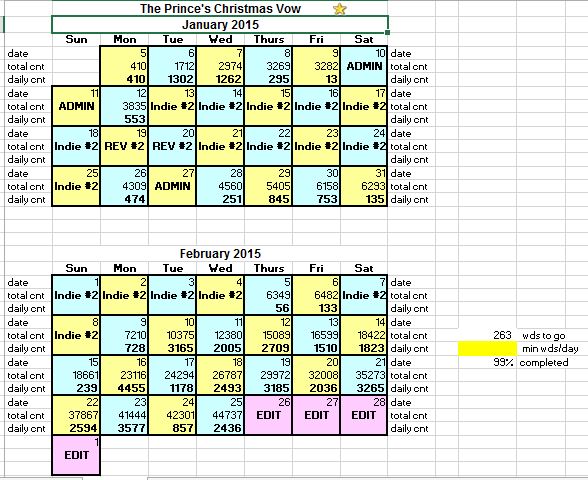
P.S. You’ll notice that some days my words counts are miniscule. That’s because I don’t turn off my email when I’m writing (not if I’m expecting something important on another book). So some days I’ll start writing only to receive a priority email. I drop everything to deal with it and I don’t usually get back to writing until the next day. Even with a small word count, it keeps me connected to the book. In the back of my mind, I’m thinking about those characters and their journey while I’m off working on other projects. Then when I return to my WIP, there isn’t as much time wasted getting back into the groove. 😉 It’s all one big balancing act.
Join the conversation on Twitter with the hashtag #SYTYCW15, and follow @HarlequinSYTYCW.


